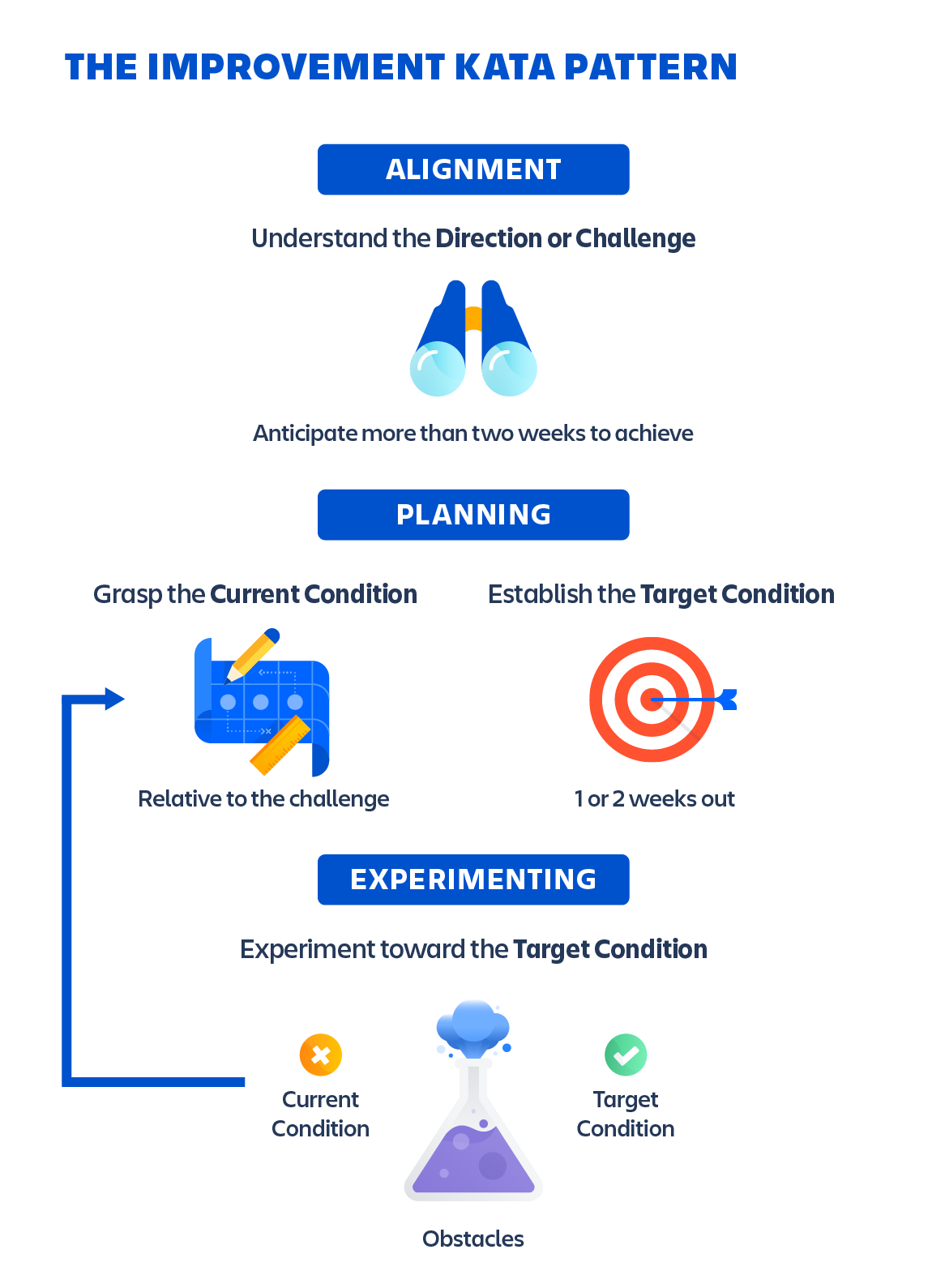Summary: Improvement Kata is a method where team leaders and members continually practice a kata routine that develops and channels their abilities to solve problems. It’s a set of practices outlined in the book Toyota Kata that use experimentation to help work towards a complex goal by breaking it down into smaller, immediate targets.
In martial arts, a kata is a choreographed pattern of movement practiced by a disciple to memorize and perfect martials arts movements. This practice of practicing a routine until it became a refined habit now extends beyond martial arts and into business.
In particular, the Toyota Motor Corporation developed continuous improvement through practiced patterns. This technique, called Improvement Kata, was discovered and documented in the business book Toyota Kata.
What is Improvement Kata?
Improvement Kata is a method where team leaders and members continually practice a kata routine that develops and channels their abilities to problem-solve. Over time, the practices become second nature. It’s a set of practices outlined in the book Toyota Kata that use experimentation to help work towards a complex goal by breaking it down into smaller, immediate targets.
The Improvement Kata routine seeks to problem solve in a more creative, directed, meaningful way. It seeks to do so with a four-part model:
- Understand the direction or challenge
- Grasp the current condition
- Define the target destination
- Move toward the target iteratively, which reveals obstacles to overcome
These techniques are particularly helpful when the route to a destination is unclear, as experimentation can help you better understand the problem and find unique solutions.
Each step of the Improvement Kata pattern has simple practice routines, called starter katas, that make the pattern easily actionable and teachable.
What are the benefits of Improvement Kata?
Today’s tech environment is incredibly dynamic, and this presents challenges that are more complex than ever. Improvement Kata is a scientific, goal-oriented method of working that enables individuals and teams to tackle these challenges efficiently, and mastery of the technique can offer numerous benefits beyond a structured method of operations. These benefits include:
Teams aligned toward a single goal
When teams share the same definition of success, there is more collaboration, less confusion, and higher productivity. This is because they understand how they can best contribute to a larger objective, giving teams a greater sense of ownership over their work, strengthening their commitment to the overarching vision, and encouraging proactive decision-making that prioritizes movement towards the end goal.
Experimentation leads to results
When you know where you want to go but you’re not sure how to get there, the first step always seems to be the greatest challenge. However, adopting experimentation as a regular practice can help ease the uncertainty and serve as a vehicle towards your final destination. Make hypotheses about how you can get to where you want to be, and initiate experiments to determine if you’re correct. If that’s not the correct path, there’s no harm in course correcting. In any case, you now have a better sense of what the right direction is. Experimentation is all about learning and resolution.
Reduce waste significantly
Focusing on small, sustainable improvements can minimize time and energy wasted on activities that don’t contribute to the solution. For example, when you review the tasks in your backlog, you should ask yourself: will this bring me closer to my next milestone and overall goal? You can also take this a bit further: given the time I have left in this increment, do I think I have the knowledge to remove blockers and tackle the tasks at hand, or should I defer them? I found this tactic useful to avoid wasting days or weeks on a problem that requires tangents to remove obstacles.
Improvement Kata reduces waste for developers, managers, and teams. For example, developers should not focus on building extra features that are nice but unnecessary. A milestone-oriented process can help ensure they’re building with intent. Similarly, managers or tech leaders who follow principles of Improvement Kata should be diligent about removing blockers that hinder immediate progress. Finally, Improvement Kata can benefit teams as a whole by promoting constant communication, efficient feedback loops, and continuous delivery.
Steps to implement Improvement Kata
Coordinating between what we think will happen to what actually happens and what is learned from the discrepancies is at the heart of Improvement Kata. While this may seem simple enough, the challenge is that not all of us are wired to think like this. Integrating Improvement Kata practices into your workflow takes consistent, mindful practice.

Find your North Star
The first step is to clearly understand the direction or challenge. This helps inform the planning and experimentation phases. If you struggle to identify what your North Star is, consider how your team might contribute to your organization’s larger goals or how you can leverage your team’s strengths to turn a particular vision into a reality.
Establish the current condition
Before you begin working towards your North Star, take time to document current processes and workflows, review where your team stacks up against appropriate metrics, and assess the team’s existing knowledge infrastructure. Be honest about what your current condition is so that you can identify meaningful steps towards your ultimate goal.
Choose your next target
Once you have a clear understanding of current systems and processes, identify the next target condition, or where you want to be after your next iteration. The next target should be a single, tangible change that can be achieved in a matter of weeks/sprints and bring you closer to your North Star.
Conduct experiments until you reach your target
Now that you have a vision of what your next target is, form a hypothesis about how you can get there. Come up with ideas on where to start and what to try, and don’t be afraid to fail!
Get to the goal the fastest way possible
Speed is necessary even if it means cutting corners and using clever hacks along the way. You’ll either get confirmation early that it can be done, or you find unforeseen challenges to tackle. If it doesn’t work, turn it into a learning opportunity.
Clean up the rough edges
Once you verify it works, move backwards to polish the corners you’ve cut, and smooth out any rough edges that need to be refined.
What are some examples of Improvement Kata?
Say you want to build a new service based on an idea, but you’re not sure whether it will work. Rather than trying to get every layer perfectly worked out and incrementally expanding it until it’s feature-complete, try picking a target that delivers some value and brings you closer to the system you envisioned. You’ll probably have lots of unknowns, but you can learn a lot from challenges, and experiment with different ideas to find one that works. Once it does, reevaluate where you are, pick your next target, iterate, and reflect on your progress.
Another example is if you maintain an internal system that needs improvements. Pick one you are ready to tackle and brainstorm some ideas on how to solve it. Experiment with different approaches and try to complete it as fast as possible to start getting some feedback about it. Once things are good enough, move on to the next problem to solve.
What are the differences between Improvement Kata and lean?
Kata and lean are different, yet compliment each other. Kata and Lean are different in many ways. Lean refers to processes to be implemented while kata refers to techniques to be practiced. Thus, kata became a mainstream business practice when Toyota adopted it into its lean production system. When combined into a unified approach, these concepts provide powerful results.
Both kata and lean principles focus on enabling faster progress, but slightly differ in their approaches.Kata is a set of habits that can be deployed at the individual-level and focuses on continual improvement and learning through experimentation. It is useful for tackling problems with uncertainty, while learning and developing skills to repeat the solutions faster and faster. It helps embracing the unknown, and teaches not to fear challenges and obstacles.
Lean principles, such as Lean Portfolio Management, help organizations and teams improve processes and workflows such that the greatest value can be extracted with minimal waste. Once a process is established, the focus is optimizing it to be as fast and efficient as possible.
How can you use Improvement Kata and lean together?
Improvement Kata are habits and techniques that teams can use to reinforce lean principles. While the two approaches focus on different things, they both came from Toyota originally, and can be used well together. For example, the lean philosophy hinges on eliminating wasteful activities so teams can extract and deliver the most value. Improvement Kata supports this goal by minimizing waste through routine experimentation. If one method does not yield expected results, then it is removed from the process.
The goal-oriented teachings of Improvement Kata encourage completing a task before moving to the next, so the process is continuously refined until it achieves intended results and thus achieves greater organizational efficiency, yet another pillar of the lean philosophy. Above all else, Improvement Kata offers tools that can be used in the present state to get to a lean future state. Breaking down larger objectives into smaller pieces means that each of those parts will be optimized for its intended purpose. Ultimately, this means that the entire system will thus be able to generate maximum value.
In conclusion...
Improvement Kata is a valuable tool that supports the goals of the lean philosophy. When employees and teams adopt a goal-oriented approach, they can easily drive incremental change that maximizes the use of limited resources while minimizing waste. Together, Improvement Kata and lean can help organizations be more efficient and develop a culture of innovation.
Are you Interested in learning more about Improvement Kata and Lean Portfolio Management? Dive deeper into the fundamentals of Lean Portfolio Management and see how Atlassian's Jira Align supports it.
